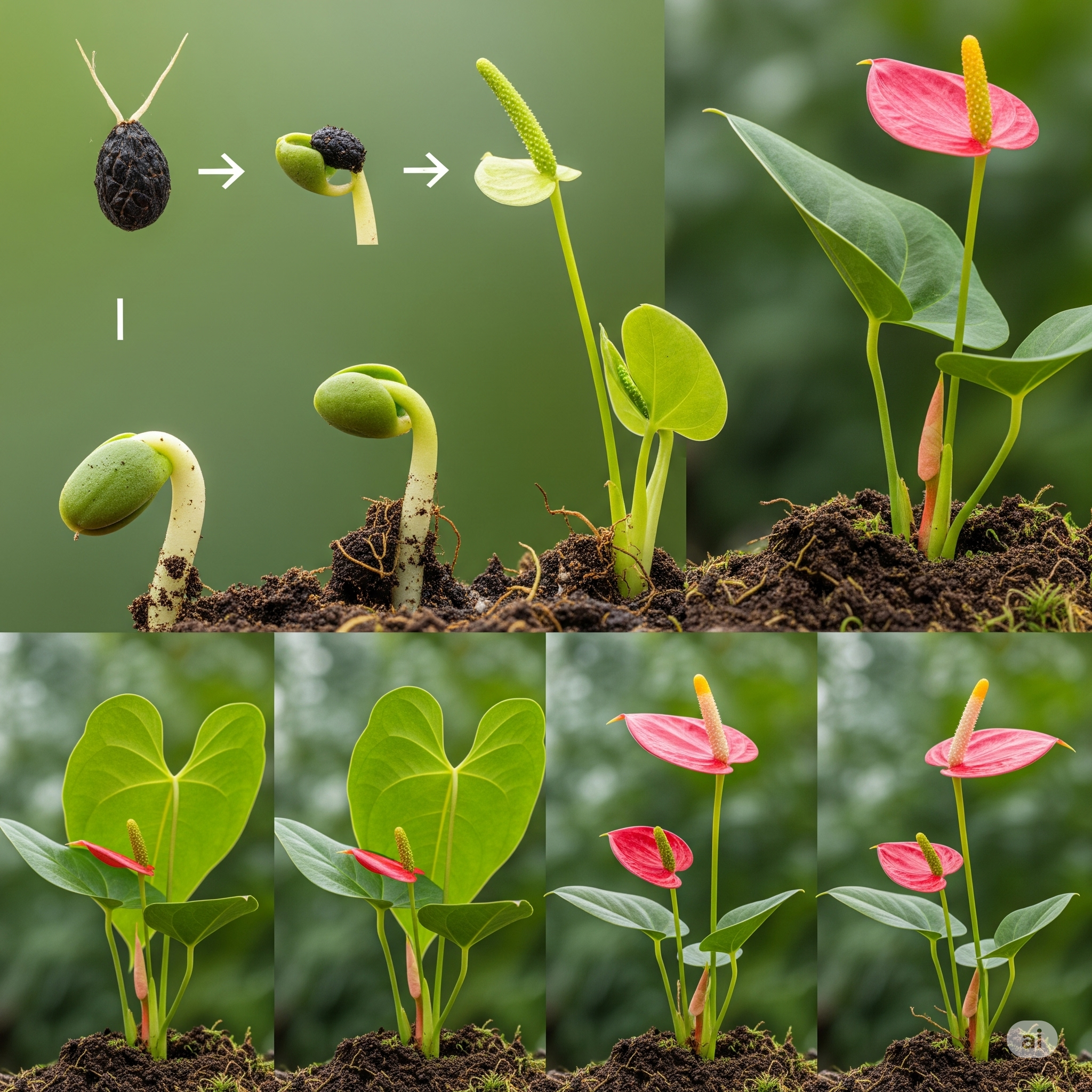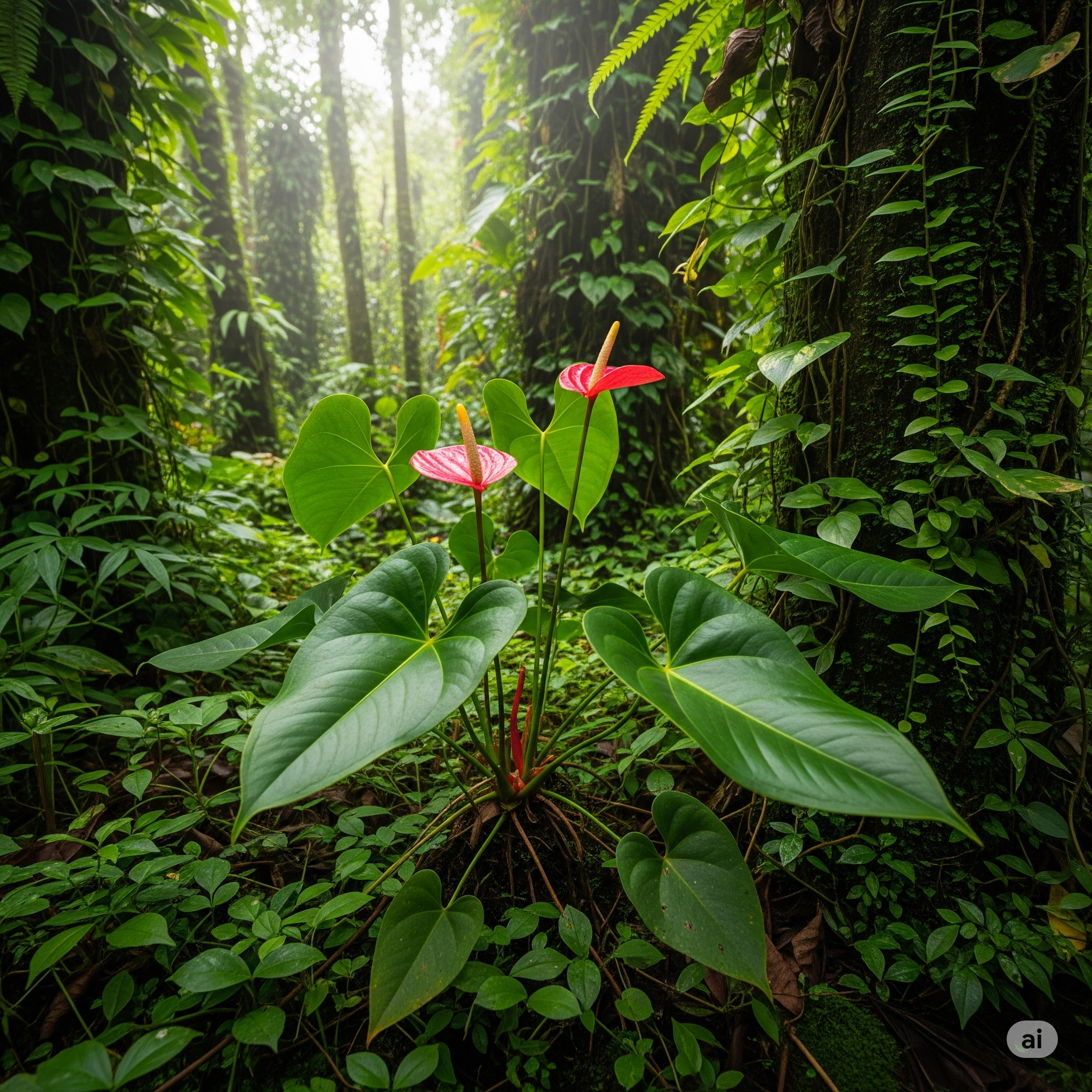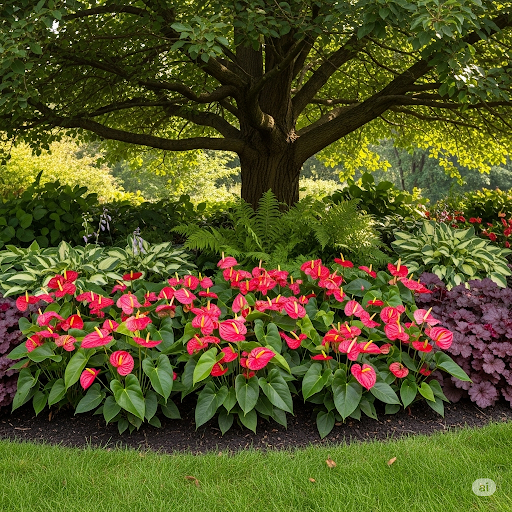The Anthurium flower is a perennial herbaceous plant belonging to the Anthurium genus in the family Araceae (arum family). Typically native to tropical and subtropical regions, this plant is widely used as an ornamental houseplant due to its aesthetic appearance and long-lasting blooms. Native to the humid forests of Central and South America, the anthurium represents significant biological and economic diversity, both in its natural populations and cultivated forms. It is frequently studied in scientific research for its physiological resilience, tolerance to environmental stress factors, and enhanced flowering characteristics. Moreover, it holds a prominent place in the cut flower industry.
Biological Characteristics and Systematic Position
Morphological Structure
Anthurium plants are notable for the shape and size of their leaves and the color variation of their flowers. The characteristic structure of the plant typically includes broad, heart-shaped leaves and a colorful spathe (a modified bract with a glossy, waxy texture), from which the spadix (flower spike) emerges. The spathe may appear red, pink, white, or green. While it is commonly perceived as the “flower” in popular understanding, the actual floral structure in botanical terms is the spadix. The spadix is a fleshy axis densely packed with small flowers and contains the plant's reproductive organs.
The showy structure derived from specialized leaves promotes insect-mediated pollination. Since pollen production occurs with a temporal separation between male and female phases, self-pollination is largely prevented. This mechanism is important for maintaining genetic diversity.

Anthurium Flower Growth Process (Generated with Artificial Intelligence)
Systematic Position
Anthurium is a genus belonging to the class Magnoliopsida, order Alismatales, and family Araceae. Within this family, the Anthurium genus encompasses nearly 1,000 species, making it one of the largest genera in the Araceae family. Morphological characters such as leaf shape, spadix length, spathe color, and root structures form the basis of the genus's systematic classification. Genetic studies, supported by molecular phylogenetic data, have contributed to clarifying the evolutionary relationships between species.
Anatomical and Physiological Characteristics
The Anthurium plant possesses mesophytic tissues with high photosynthetic capacity, a thick cuticle layer, and well-developed stomata. These features enable it to survive in both high-humidity environments and indoor conditions. Although it does not utilize the C4 photosynthetic pathway, it has a high light saturation point and optimally benefits from morning light. The root system includes specialized structures capable of absorbing nutrients and moisture from both the soil and the air.
Ecological Distribution, Habitat, and Cultivation
Natural Distribution Areas
The Anthurium flower naturally occurs in the tropical Americas, extending from southern Mexico through Colombia, Ecuador, Peru, and Brazil. These species primarily inhabit the understory of temperate rainforests, thriving in moist, shaded environments with rich humus soils. Some species are epiphytic (growing on trees), while others are lithophytic (growing on rock surfaces). Their ecological adaptations allow these species to survive in diverse microhabitats.

Anthurium Flower (Generated with Artificial Intelligence)
Cultivation Conditions
Light intensity, temperature, humidity, and soil structure play a critical role in anthurium cultivation. The plant does not tolerate direct sunlight; indirect and filtered light provides the optimal growth environment. The ideal temperature range is 18–28°C, with low day-night temperature differences recommended. Relative humidity should be above 70%. The soil pH should be slightly acidic (pH 5.5–6.5).
Well-drained, organic matter-rich, and aerated soil mixtures are preferred. Commonly used substrates include mixtures of peat, pine bark, perlite, and coconut fiber. Watering should be done by allowing the top layer of the soil to dry slightly; overwatering must be avoided. The plant is sensitive to root rot.
Propagation and Production Techniques
Anthuriums are mainly propagated vegetatively, through division and cuttings. Seed propagation is also possible, but more time-consuming and may produce heterogeneous results due to genetic variation. Tissue culture techniques are widely used, especially in commercial production, as they enable high-yield seedling production under sterile conditions.
Pests and Diseases
The main pests encountered in anthurium cultivation include aphids, red spider mites, and mealybugs, while diseases include bacterial leaf spot (Xanthomonas spp.), root rot (Pythium spp.), and anthracnose (Colletotrichum spp.) fungal infections. Cultural practices, adequate air circulation, and sanitation measures are important for controlling these diseases.
Economic Importance, Usage, and Cultural Role
Use as Cut Flowers and Ornamental Plants
The anthurium flower is one of the important species in the cut flower industry due to its long-lasting and aesthetic floral structure. The color durability of the spathe, the upright posture of the spadix, and the overall form of the plant make it widely used in floral arrangements. Vase life typically ranges between 2 and 3 weeks. It is also highly popular as a potted indoor ornamental plant. Due to its tolerance to low light conditions and long-lasting leaves, it is widely used for decorative purposes in offices and indoor environments.

Anthurium Flower (Generated with Artificial Intelligence)
Role in Medical and Biological Research
Pharmacological studies on extracts obtained from anthurium plants have indicated that certain species may possess antimicrobial and antioxidant properties. However, direct clinical applications for medicinal use remain limited at present. Additionally, the plant is evaluated as a model organism in biotechnological research, particularly in studies of genetic resistance, cell differentiation, and flower morphogenesis.
Cultural and Aesthetic Values
The anthurium flower is widely used in modern landscape designs to represent tropical areas. In some cultures, it is regarded as a symbol of love, elegance, and permanence. Consequently, it is often chosen as a decorative element in weddings and memorial ceremonies.
Global Production and Trade
Countries such as the Netherlands, Colombia, Ecuador, and Thailand are leaders in anthurium production. The annual export volume is increasing, especially in regions with favorable tropical climates. Colombia and Ecuador are prominent exporters of cut flowers, while potted anthuriums are mainly marketed in European and North American markets. The global trade share of anthurium holds significance both economically and in terms of ecological sustainability.


